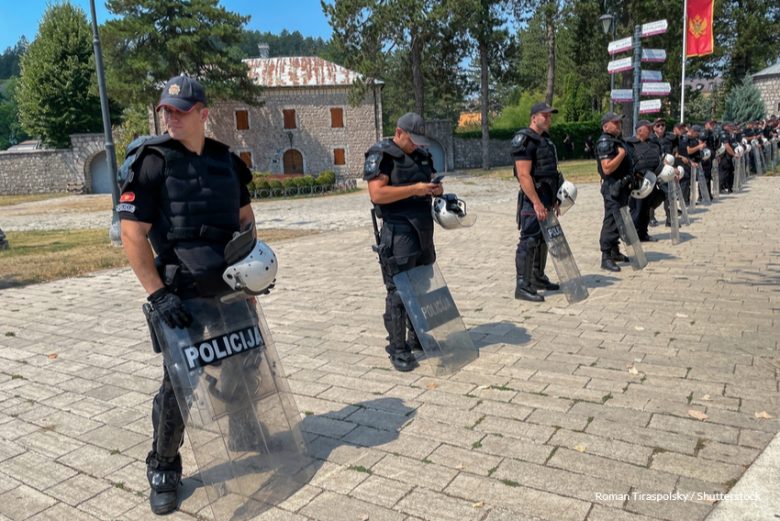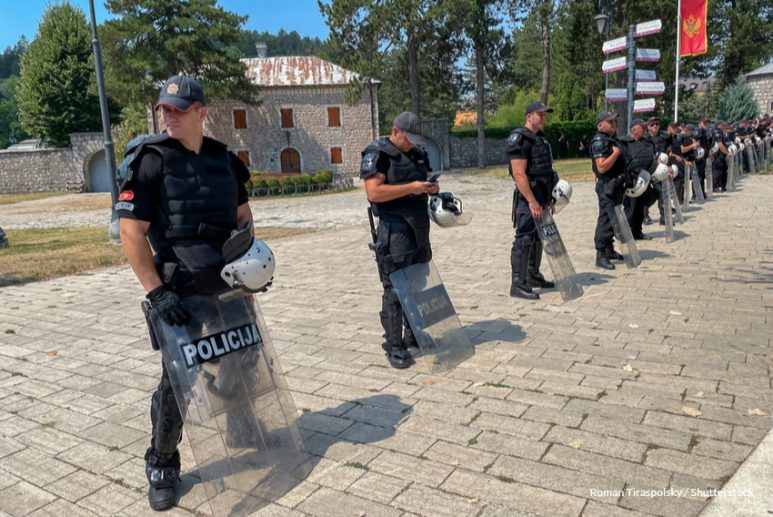This post was initially published on Reporting Diversity 2.0
By Elvira Jukic-Mujkic
Hearing my two Montenegrin colleagues recently describe what they felt on September 5th – one describing mostly peaceful protest with cooperative police in Cetinje and the other one a terrifying panic over her impression that there is a violent chaos taking place as following the media and social networks from home – to me sounded like a perfect experiment of how media can shape the perception. But this was not the only example where one could see opposing versions of what happened around the enthronement of the Serbian Orthodox Church’s Joanikije II in the Montenegrin town of Cetinje monastery. Depending from where you tuned in, followed from or whether you participated in the Cetinje events earlier this month, it could seem as different events and places.

Days before the disputed enthronement and still continued, the media sphere was filled with different versions of what was to happen – one could gather both that Serbian extremists are taking over Montenegro and that the Montenegrin nationalists were trying a coup d’état. Accusations of extremism flew around on all sides as well as qualifications such as “hordes”, “terrorists”, “betrayal”, “fascization”, “occupation”. How to make sense of it?
The enthronement
People from several cities in Montenegro gathered in Cetinje to protest against the enthronement of the Metropolitan of Montenegro and the Littoral of the Serbian Orthodox Church seeing it as a way of still claiming Montenegro as part of Serbia, from which it separated in 2006. Protesters stood against denial of Montenegrin national identity and against claim of the country’s historical capital as place of enthronement for the Serbian Orthodox Church.
By blocking the roads that lead to the town, the protesters did not allow the Serbian patriarch and clergy from coming to the Cetinje monastery. Police used teargas to push back hundreds of protesters some of whom threw rocks at them and set tires on fire. Persistent for the enthronement to take place, backed by the Montenegrin government, the clergy arrived to the monastery by military helicopter. Under the protection of bodyguards and sniper blanket, the priests held the ceremony for Joanikije. Dozens were injured and arrested, including an advisor to the president and former police director.
While the current prime minister Zdravko Krivokapic helped and welcomed the event, the country’s president and virtual ruler of Montenegro of three decades Milo Djukanovic saw it as a way of still present or a renewed influence of Serbia and Russia. More and more visible in the recent years, the two ethnic blocs, Serbian and Montenegrin, set out to be the basis of deep divisions in the country of about 600,000 people, about three quarters of whom are Orthodox Christians. After years of Djukanovic’s party dominance, from last year the ruling coalition in Montenegro is headed by Krivokapic and the government seen as leaning towards Serbia. Meanwhile, the disputed Freedom of Religion Law raised questions over the ownership of properties of religious communities, as the initial law foresaw that the state of Montenegro would be registered as owner of any real estate or facility that did not have proof of ownership from before 1918 when this country was part of Kingdom of Serbs, Croats and Slovenes.
In the media
Despite the teargas, stone throwing and political and ethnic tensions, the protests of citizens holding Montenegrin flags sent a message of pride in their identity and struggle of political independence from Serbia. Meanwhile, the declared Serbs in Montenegro (about a third of population), their political representatives and the Serbian Orthodox Church made their mark with the enthronement of Joanikije. What remains is the divided Montenegrin society that many deem as shadowed by similar dark spirits as those from the ‘9o-ties that troubled the region. And similarly, the media seem to be politically instrumentalised for warmongering by not reflecting the reality but significantly influencing it.
In ethnically and religiously divided societies, the media often stand servile to divided audiences and opposing political options, usually fuelling opposing narratives. In such circumstances, as visible in Montenegro as well, the majority of media are not the ones to break the divisive cycles but they rather keep them running. And what the audiences do is find the media outlets, as well as individual voices on social media, that best reflect their already existing views, keeping them away from stepping out from their zones of comfort and far from observing what surrounds them with a critical eye, especially in burning moments like early September saw in Cetinje.
The mainstream media in Montenegro, and those inevitably influential ones from Serbia, have one thing in common – fuelling tensions by offering conflicting versions of what is happening and what it all means for the country.
“Cancellation was not an option at any point as some media outlets reported. The state was defended!” wrote prime minister Krivokapic in a tweet following calls and reports about the enthronement of Joanikije not to be held in Cetinje. This was republished as a victorious statement in the pro-Serb media and with criticism in the Montenegrin media which emphasized the unwelcomeness of the event in the old capital. Criticized for putting lives of citizens at risk and actually working against the state of Montenegro, Krivokapic is being accused for working in the interests of Serbia and betraying ethnic Montenegrins.
Sharing his belief prior to September 5 that the enthronement will not take place in Cetine, the president Djukanovic said that Podgorica should be the place for the ceremony. “They cannot do this by force, by endangering freedom of expression and the rights of citizens of the capital. That is not a good approach. Even if someone would succeed in this, he would always have to feel as if he forcefully created his wish here, as someone who violated the capital and its citizens,” he added.
From what could be seen from outside of Montenegro, the mainstream media covered the events and presented the main messages – who said what. It seemed like everyone did their usual job. On a nothing but a usual day, and moment in time.
Hundred kilometres away, driving towards Croatia, my colleague and I stubbornly searched for an internet streaming of a live open programme of a local television or a radio station. Except of short and dry news updates from the Montenegrin state radio, not much remained than to stick to online media and social networks. And there, depending on where you stand politically, you could read about extremists on all sides, hooligans and occupiers, rights to freedom and violation of freedom of the others, patriots and intruders, and the list of adverbs can go on and on.
Despite the efforts of dozens of hard-working reporters who spent days and nights in the field, capturing what they saw and heard, what results when their materials are put through the grinding machines of newsroom editorials, mainstream media and social networks, does not turn out always right. Consequently, the opposing realities presented in the media are dangerous in the region where long-time historical disputes re-emerge every now and then and suck in new generations in repeated tensions. Divided media create parallel realities for different people and it is now not clear if there is a way for the citizens of Montenegro to overcome the divisions served by politicians through the media.
For my Montenegrin colleague who followed the media and social networks from home kilometres away from Cetinje, fear that the culmination of the events will end up in a blood shell is understandable. Luckily, she knows better than to stick only to that experience, but she might not belong to the majority.
Photo Credits: Roman Tiraspolsky / Shutterstock

